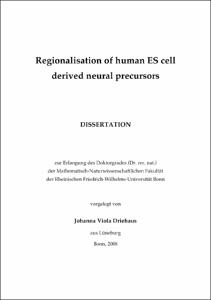Driehaus, Johanna Viola: Regionalisation of human ES cell derived neural precursors. - Bonn, 2009. - Dissertation, Rheinische Friedrich-Wilhelms-Universität Bonn.
Online-Ausgabe in bonndoc: https://nbn-resolving.org/urn:nbn:de:hbz:5N-16882
Online-Ausgabe in bonndoc: https://nbn-resolving.org/urn:nbn:de:hbz:5N-16882
@phdthesis{handle:20.500.11811/4044,
urn: https://nbn-resolving.org/urn:nbn:de:hbz:5N-16882,
author = {{Johanna Viola Driehaus}},
title = {Regionalisation of human ES cell derived neural precursors},
school = {Rheinische Friedrich-Wilhelms-Universität Bonn},
year = 2009,
month = mar,
note = {The derivation of region-specific neural cells from human embryonic stem cells holds great promise for future cell replacement strategies of neurodegenerative diseases. However, the possibility to recreate the diversity of the mature CNS with its numerous types of neurons displaying distinct region-specific transcription factor expression profiles in vitro using defined morphogens seems limited. Therefore this study sought to investigate whether primary cells from different regions of the developing rodent brain - which themselves are known to be regionally specified - can influence the regional identity of human ES cell-derived neural stem cells (hESNSCs).
After establishing the regional gene expression profile of the hESNSCs under standard culture conditions in vitro, the cells were exposed to paradigmatic co-culture settings. To that end cells from forebrain, midbrain, hindbrain/cerebellum and spinal cord of embryonic and P0 mice as well as hippocampal and cerebellar slices of 9-day-old rats were used. To analyse the gene expression of co-cultured human cells human-specific real time RT-PCR primers were designed and implemented. Surprisingly, neither co-culturing with nor transplantation onto or even in vivo transplantation into different brain regions induced significant changes in region-specific gene expression in the hESNSCs.
As it is known that the developmental potential of ES cells can be in part ascribed to their dynamic epigenetic state it was subsequently tested whether subjecting the hESNSCs to DNA demethylation and histone hyperacetylation would alter their developmental competence. Remarkably, even modifying the epigenetic state did not suffice to increase the responsiveness of hESNSCs to primary cell derived cues. However, administration of VPA and AzaC seemed capable of intensifying the effect of defined morphogens such as retinoic acid and BMP4 to posteriorize and dorsalize the hESNSCs, respectively.
These observations suggest that hESNSCs retain a responsiveness to high levels of single morphogens but are not easily amenable to regional specification by tissue derived environmental cues even after DNA demethylation and histone hyperacetylation.},
url = {https://hdl.handle.net/20.500.11811/4044}
}
urn: https://nbn-resolving.org/urn:nbn:de:hbz:5N-16882,
author = {{Johanna Viola Driehaus}},
title = {Regionalisation of human ES cell derived neural precursors},
school = {Rheinische Friedrich-Wilhelms-Universität Bonn},
year = 2009,
month = mar,
note = {The derivation of region-specific neural cells from human embryonic stem cells holds great promise for future cell replacement strategies of neurodegenerative diseases. However, the possibility to recreate the diversity of the mature CNS with its numerous types of neurons displaying distinct region-specific transcription factor expression profiles in vitro using defined morphogens seems limited. Therefore this study sought to investigate whether primary cells from different regions of the developing rodent brain - which themselves are known to be regionally specified - can influence the regional identity of human ES cell-derived neural stem cells (hESNSCs).
After establishing the regional gene expression profile of the hESNSCs under standard culture conditions in vitro, the cells were exposed to paradigmatic co-culture settings. To that end cells from forebrain, midbrain, hindbrain/cerebellum and spinal cord of embryonic and P0 mice as well as hippocampal and cerebellar slices of 9-day-old rats were used. To analyse the gene expression of co-cultured human cells human-specific real time RT-PCR primers were designed and implemented. Surprisingly, neither co-culturing with nor transplantation onto or even in vivo transplantation into different brain regions induced significant changes in region-specific gene expression in the hESNSCs.
As it is known that the developmental potential of ES cells can be in part ascribed to their dynamic epigenetic state it was subsequently tested whether subjecting the hESNSCs to DNA demethylation and histone hyperacetylation would alter their developmental competence. Remarkably, even modifying the epigenetic state did not suffice to increase the responsiveness of hESNSCs to primary cell derived cues. However, administration of VPA and AzaC seemed capable of intensifying the effect of defined morphogens such as retinoic acid and BMP4 to posteriorize and dorsalize the hESNSCs, respectively.
These observations suggest that hESNSCs retain a responsiveness to high levels of single morphogens but are not easily amenable to regional specification by tissue derived environmental cues even after DNA demethylation and histone hyperacetylation.},
url = {https://hdl.handle.net/20.500.11811/4044}
}






